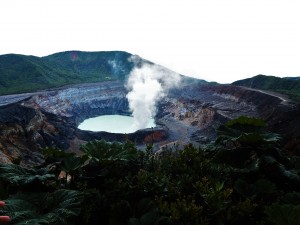When traveling every weekend is taking its toll, a day trip sounds perfect: quick and simple and still a way to get out of the house. Usually, though, a short trip without a tour company still requires you to set aside a lot of time for planning.
While Madison and I had a finish line in mind, we weren't sure what path to take to arrive there. Because it was considered "unusual" to travel to Poás independently, information on how to get there was mixed and difficult to find. We compared info from a variety of sources--Maggie (one of our advisers at CEA San José), the Internet (where we found websites with users that had the same question as us), and other students at Veritas who had previously visited Poás--and made loose plans, hoping that we would recognize where to go and what to do next as we continued.
 |
| The buses that traverse San José mostly all look like this inside, and they all cost less than a dollar per ride! |
TRAVEL RULE: Plan for the unplannable, and leave extra time. Earlier is always better.
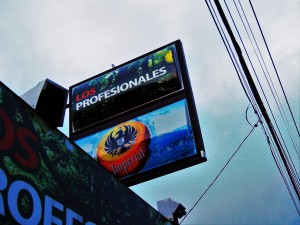 |
| This bar is only a few blocks from campus and is a good landmark to help you find the bus stop. |
TRAVEL RULE: Don't be afraid to ask people for confirmation on where you are going. It's better to be sure than worried you'll end up in the wrong place.
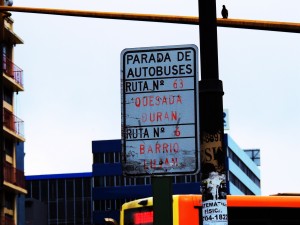 |
| You will get off the bus in front of the church, and when you want to return after your trip, wait at this same sign for the bus that says LUJAN. |
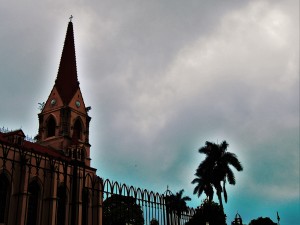 |
| You can't miss this steeple rising higher than the palm trees in the park. It's right across the street from the park and the park is right across the street from the bus station. |
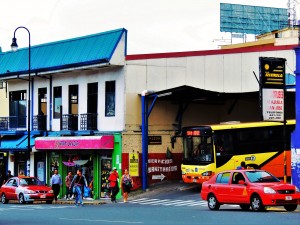 |
| The bus station is obvious once you see the many TUASA buses pulling onto the street. |
Inside the bus garage, I could see that each bus had the name of its destination printed on a paper that was pasted behind its glass windshield. The next bus we planned to take was to Alajuela, so that's what I searched for. When a man asked where we were going, I had to say "to the Alajuela airport" ("Vamos al aeropuerto de Alajuela.") because only the buses that passed the airport would take us to the next bus garage we would need to find. He pointed out the correct bus, and within minutes of boarding we were
on our way to Alajuela.
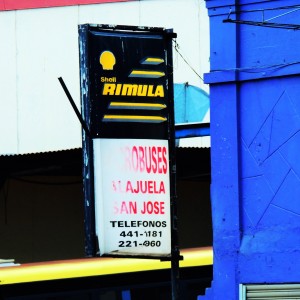 |
| A close-up of the sign you should look for that denotes the station where the TUASA buses lie in wait for your great adventure! |
the bus garage where we expected to find the next bus which was then supposed to take us directly to Poas.
The large green bus sat on the other side of the street, facing the direction that our last bus had just come from. Would we be backtracking? Were we really that far off from where we were supposed to be? I wondered. I asked the bus driver if he would be going to Poàs, but of course he wouldn't be making it to the park. He was just another city bus driver. He understood where we needed to be, though, and after many (many many many!) stops for people along the road up the volcano, the driver called us forward and told us that the bus to Poàs National Park was stopped at the restaurant to our left. We were saved!
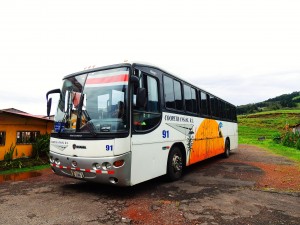 |
| The bus that was conveniently waiting for us at the restaurant. |
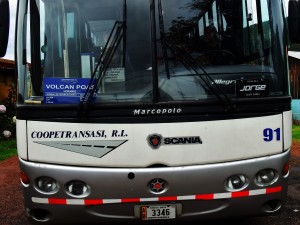 |
| A close view of the windshield of the bus that will take you to Volcán Poás. |
The (real) Poas bus was taking a fifteen minute break, so we had time to oggle the fat, red strawberries and other assorted fruits being sold at the front of the restaurant, as well as use the restrooms before we would continue another thirty or fourty minutes up to the park. Because we caught the bus halfway through it's journey, it only cost us about 700 colones.
TRAVEL RULE: Research the climate of your destination. It's not fun being hot nor being cold, so if you have room, you might want to bring some extra layers.
TRAVEL RULE: You probably won't realize you're experiencing miracles. Never forget how fortunate you are to see what you do and to do what you do, and don't forget to continue seeing and doing everything while you can.
What a wonderful, humbling feeling to be so close to a volcano!
View of Poas Volcano: Priceless











